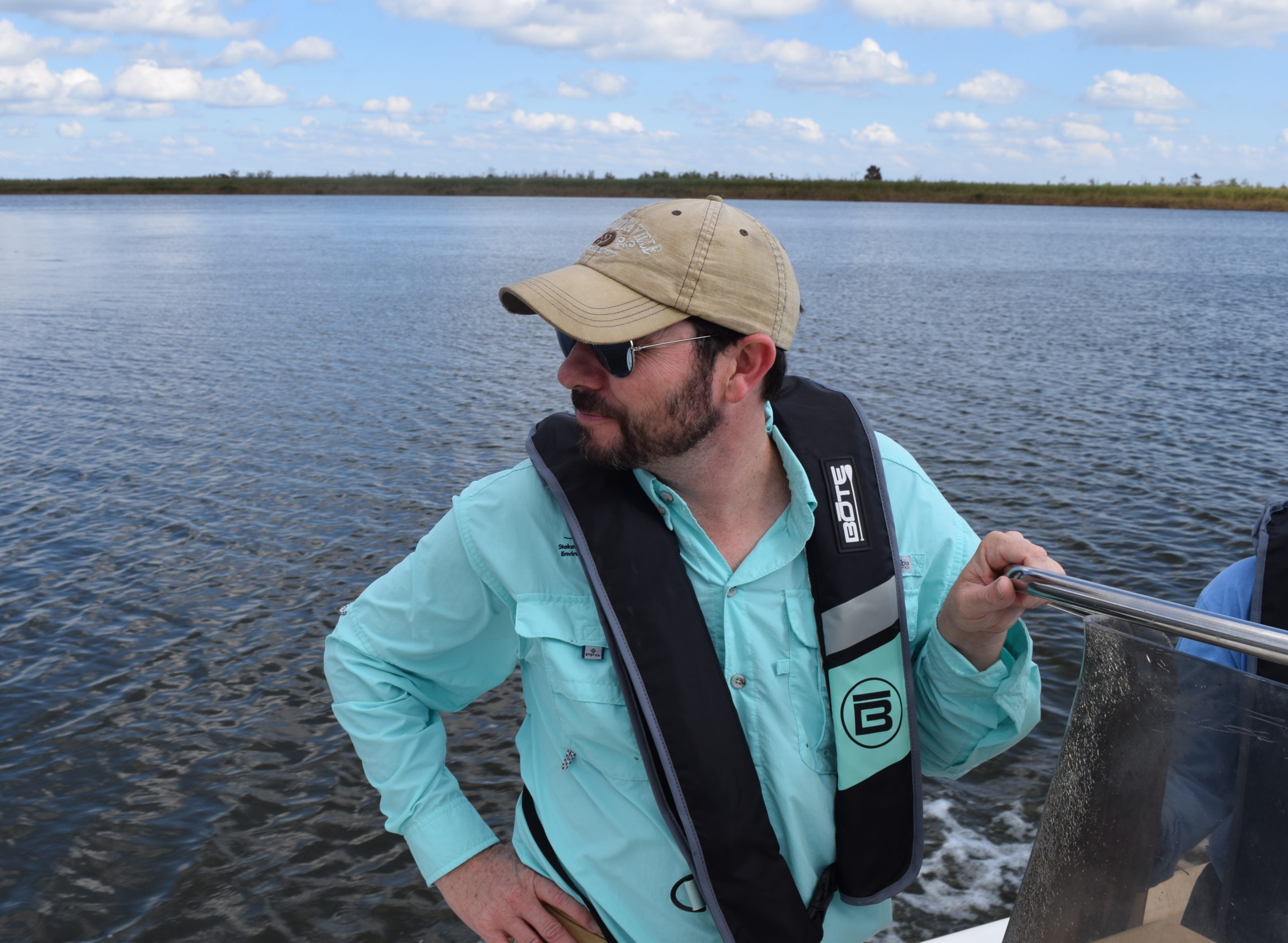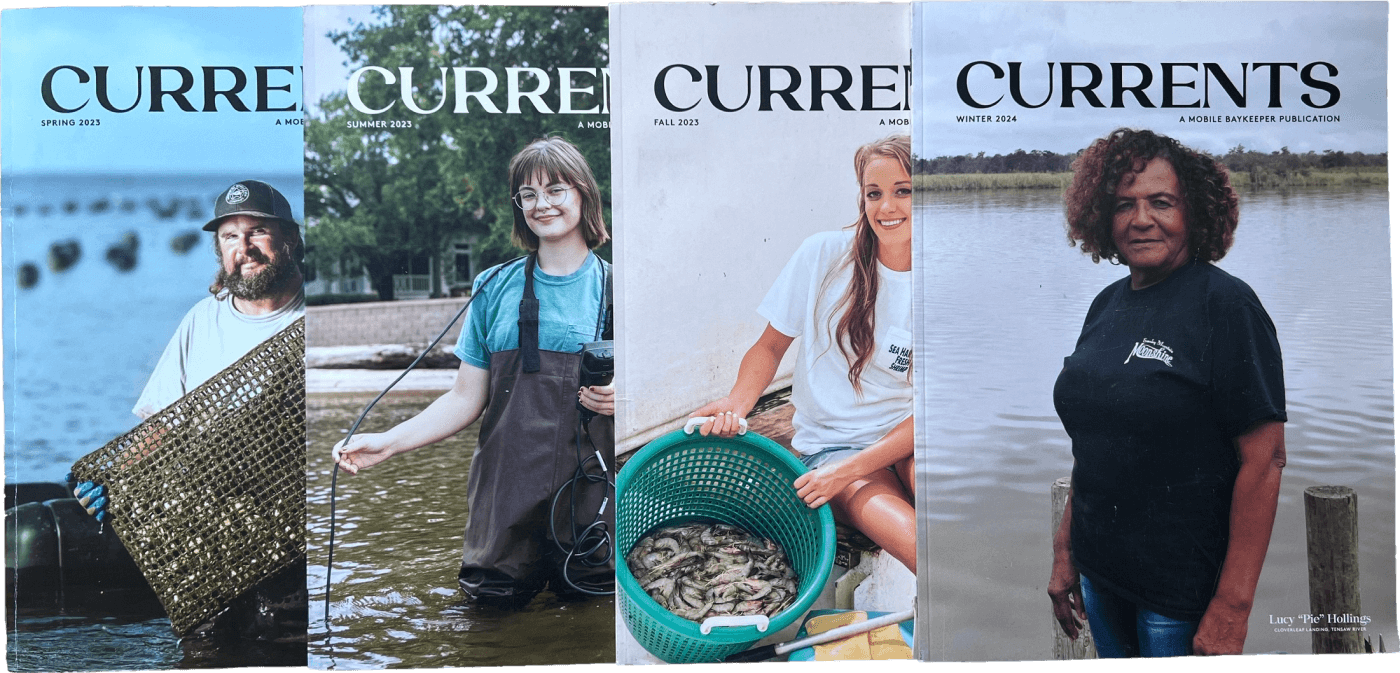
This article is from the winter edition of Mobile Baykeeper’s print quarterly, CURRENTS. The magazine is mailed to active members who have given more than $50 in the past year. To get on the magazine’s mailing list, donate here.
By Cassie Bates | Photos and video by Caine O’Rear
Charlie Martin is an Associate Professor in the Department of Marine and Environmental Sciences at the University of South Alabama, and a Senior Marine Scientist at the Dauphin Island Sea Lab. Charlie specializes in coastal and estuarine ecological studies with interests in restoration, invasive species, plant-and-animal interactions, and effects of human-based stressors on ecosystems. We caught up with him recently during a trip out in the Delta.
What led you to become interested in fresh- and saltwater plants?
I actually started out with an interest in fish and how they interact with the environment. I think this developed during vacations with my family along the Gulf Coast. We would head down to the beach, throw lines in the water, and I eventually became really fascinated with the diversity of fish we were catching. That initial spark dictated the path I chose in college and graduate school, but my interest eventually branched into the complexity of fish habitat and the role it plays in supporting biodiversity.
Ninety percent of commercial and recreational fish species depend on estuaries which provide conditions for aquatic plants to grow. These plants form the basis of the food web, so I indirectly developed a love for botany and began studying these plant communities. That transition just sort of happened unexpectedly. I suddenly wanted to know where aquatic plant communities were, why they were there, and all the threats that they face.
After starting your career studying the Mobile-Tensaw Delta, you took on opportunities in other parts of the Southeast. What is it about the Delta and Mobile Bay that drew you back here?
Well, it’s really the water that makes this such a special place. There is a dynamic mix of fresh- and saltwater which diversifies our wildlife and habitats. You never know what species you’re going to find. I have had amazing opportunities working on similar systems elsewhere, but the Mobile-Tensaw Delta has always inspired me because of the array of organisms that are concentrated at different scales. We have such a cool food web here, merging between transitioning habitats and creating unique ecotones. You can catch redfish and trout in the same net as bass and sunfish. I love that I am able to come back and explore it once again.
What makes fresh- and saltwater grass meadows so important and how would you share the message that we need to conserve and restore them?
Aquatic vegetation is incredibly important for a variety of reasons. It stabilizes sediment and absorbs nutrients, so it can facilitate good water quality. It also provides habitat for everything from grass shrimp to important fishery species. A major goal of my research program is to figure out better ways to restore, protect, and conserve these ecosystems. You know, 50 to 100 years ago, people described Mobile Bay as being covered in seagrass, and that would be great to be able to see it that way once again.
Having returned to study your “roots” in the Delta, what kind of change have you seen in your time here?
I cut my teeth working on Eurasian milfoil, which is an invasive aquatic vegetative species in the Mobile Delta. One thing I’m a little surprised by is that milfoil is still pervasive in our waterways, but it is not as prominent as I remembered it being in the mid 2000s. Species types, coverage, and expanse change with our environment, and this can bring new research questions into play to uncover why these changes happen.
Another thing I’ve noticed after driving back and forth across the Bay 20 years ago versus now is that there seems to be a lot more flooding around the Causeway. This is likely a result of rising sea levels which can have negative impacts for fresh- and saltwater grass beds. Just like plants in your backyard, aquatic vegetation also requires sunlight to make energy. As water depth incrementally increases, submerged plants receive less sunlight as it cannot penetrate through the water column as far.
What are the most significant threats to our fresh- and saltwater grass populations around the Delta and Mobile Bay?
When we think about the Mobile-Tensaw Delta, one of the most important factors to consider is the water. It comes from incredibly diverse sources up in the mountains of Tennessee, Georgia, and northeast Alabama where I grew up. It flows south to reach all these little streams and tributaries, and it all ends up filtering through the Delta before exiting the Bay and eventually the Gulf. Water is of paramount importance for a couple of reasons, one being the quantity of water which flows across our watershed. Impediments like the Causeway and dams exist across our state which alter the natural flow of water.
Quantity can also be impacted by climate change as the timing and frequency of freshwater discharge events can fluctuate with downpours versus droughts. Additionally, the quality or condition of water flowing is just as important as the quantity which flows through. This can be affected by urbanization, especially on the water. People like the water and tend to gravitate toward living on it. This development leads to less riparian habitats filtering out sediments, fertilizers, and other pollutants from entering the water.
I think these changes in quantity and quality are significantly impacting our seagrass and other vegetation, and therefore have some varied effects for Coastal Alabama as a whole. Loss of foundational habitats will have impacts on the tourism industry which relies on the use of wetlands and our estuary.
Additionally, our commercial and recreational fishing industries will suffer from the loss of resources that fish, crabs, and shrimp need to survive. You know, people come to this part of the world to visit because it’s so productive. I think you don’t have to look any further than the Deepwater Horizon Oil Spill in 2010 to imagine tragic outcomes. In one summer, we saw the degradation of the coast’s public image and the cascading effects that had on the tourism industry. Although we have long since recovered, this illustrates the point that healthy ecosystems and environments lead to a healthy economy and there are incredible consequences for us when our local environment is threatened.
What can our community do to reduce stressors on fresh- and saltwater grass beds?
One of the easiest things people can do is to be mindful of where you are and what you are doing on the water while boating. Raise your motor in shallow areas, slow down, and avoid grass beds to prevent prop scarring or creating fragments of invasive species from spreading. I want people to see aquatic vegetation and not think that they are just weeds in the way, but see them as irreplaceable and important.
Cassie Bates is the staff scientist at Mobile Baykeeper.
Top image: Charlie Martin on the Baykeeper boat in the Mobile-Tensaw Delta. Photo and video by Caine O’Rear
